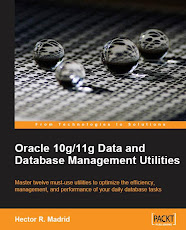This error means in general there are communication issues. It can be generic, so the outline here only depicts a very particular case.
Environment:
- Windows 2003, x86
- Oracle 11.1.0.7.0
When trying to start the listener, it took more time than usual, and after a while it showed up the following messages on the console:
Starting tnslsnr: please wait...
TNSLSNR for 32-bit Windows: Version 11.1.0.7.0 - Production
...
Connecting to (DESCRIPTION=(ADDRESS=(PROTOCOL=IPC)(KEY=EXTPROC1521)))
The listener supports no services
The command completed successfully
And when trying to display the services this was shown by the lsnrctl services command:
...
Connecting to (DESCRIPTION=(ADDRESS=(PROTOCOL=TCP)(HOST=echo.world)(PORT=15
21)))
TNS-12535: TNS:operation timed out
TNS-12560: TNS:protocol adapter error
TNS-00505: Operation timed out
32-bit Windows Error: 60: Unknown error
Connecting to (DESCRIPTION=(ADDRESS=(PROTOCOL=IPC)(KEY=EXTPROC1521)))
The listener supports no services
The command completed successfullyThe trace was enabled and the stack of messages was recorded at the trace file. By taking a look at the file a particular message came to my attention:
...
2011-07-05 15:09:59.231337 : nsinh_hoff:connection inherited
2011-07-05 15:09:59.231349 : nsinherit:connected
2011-07-05 15:09:59.237138 : nsglma:Listener's pid=3056
2011-07-05 15:09:59.249332 : nsglbgetRSPidx:returning ecode=0
2011-07-05 15:09:59.249389 : nsc2addr:(DESCRIPTION=(ADDRESS=(PROTOCOL=TCP)(HOST=echo.oracle.com)(PORT=1521)))
2011-07-05 15:09:59.249561 : snlinGetAddrInfo:getaddrinfo() failed with error 11001
2011-07-05 15:09:59.249633 : nttbnd2addr:looking up IP addr for host: echo.oracle.comFrom this point on, several other errors showed up, but this is the first point where everything began to be not normal.
The call getaddrinfo() failed, which means there was an inconsistency when trying to resolve the host IP address.
By taking a look at the hosts file and the ipconfig command output the discrepancies appeared.
Contents at the windows hosts file:
192.168.50.78 echo.world echoipconfig output:
C:\Oracle\app\product\11.1.0\db_1\NETWORK\ADMIN>ipconfig
Windows IP Configuration
Ethernet adapter Loopback Adapter:
Connection-specific DNS Suffix . :
IP Address. . . . . . . . . . . . : 192.168.2.115
Subnet Mask . . . . . . . . . . . : 255.255.255.0
Default Gateway . . . . . . . . . :
Ethernet adapter Local Area Connection:
Connection-specific DNS Suffix . : world
IP Address. . . . . . . . . . . . : 192.168.50.68
Subnet Mask . . . . . . . . . . . : 255.255.255.0
Default Gateway . . . . . . . . . : 192.168.50.1The network adapter is configured in a DHCP environment, and according to the Oracle installation manual for DHCP environments, a loopback adapter has to be configured, and its address is the one configured at the local hosts file.
So configuring the adapters according to the installation guide it makes the system to run as expected.



